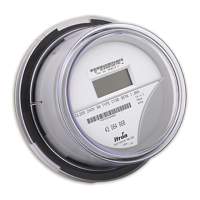Operation: C1SC Version
36 CENTRON® Meter Technical Reference Guide
After programming, the module is tested to verify the operating system parameters and FCC
compliance. A final test is performed via RF to verify a correct LAN address meter ID
number of digits and RF signal.
Physical Description
The C1SC is constructed of a flame retardant, glass-filled printed circuit board material
which supports the discrete, surface-mounted, and integrated circuitry components. A slot
antenna etched on the circuit board serves as the RF antenna. The C1SC board snaps into
the meter register mounting brackets to ease in the installation of the board. The LAN
address barcode and interpretation is placed on the LCD housing for meter identification.
The C1SC personality module is attached to the metrology board using a board to board
connector. The following information is passed from the metrology board to the C1SC:
Line Voltage
Reference Voltage
Energy Flow direction
Energy pulse data
Line frequency
The C1SC has two additional labels called the meter change-out labels that are affixed to the
bottom of the meter. The change out labels are identical and contain the AEP barcode
information and a utility descriptor.
Transmission Scheme
The RF transmission is spread spectrum using Binary Phase Shift Keyed (BPSK)
modulation. A chipping signal is used to spread the carrier and actual data is on-off-keyed
(OOK). The modulator output drives the amplifier chain that provides a signal of
approximately 100mW. The antenna is tuned for maximum efficiency at the carrier
frequency.
The figure below shows how messages are typically transmitted. In the example, an interval
packet made up of 18 intervals is transmitted every five minutes. Each interval contains a
pulse count equivalent to the energy consumption for a 2.5 minute interval. The interval
packet transmission represents a sliding 45 minute window of data.
Also shown in figure below, Interval packet 0 shows that the 2.5 minute interval is
transmitted in one of the 18 packets of 2.5 minute information. Interval packet 1 is
transmitted 5 minutes later and the selected 2.5 minute interval of data is now transmitted as
the 16th packet (numbered 15). The following packet slides the information by two 2.5
minute intervals and continues for a total of nine transmissions. The information is then no
longer in the sliding 45 minute window.

